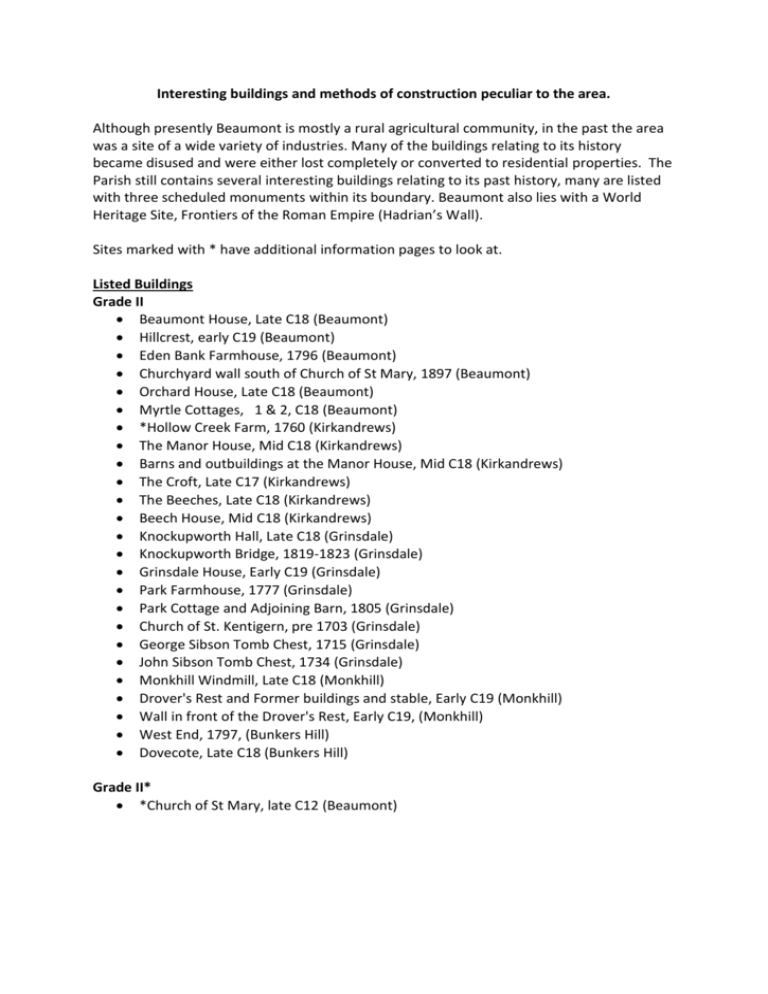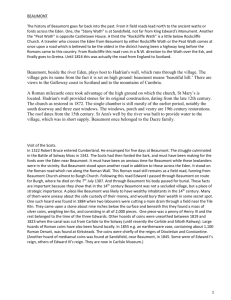Interesting buildings and methods of construction peculiar to the
advertisement

Interesting buildings and methods of construction peculiar to the area. Although presently Beaumont is mostly a rural agricultural community, in the past the area was a site of a wide variety of industries. Many of the buildings relating to its history became disused and were either lost completely or converted to residential properties. The Parish still contains several interesting buildings relating to its past history, many are listed with three scheduled monuments within its boundary. Beaumont also lies with a World Heritage Site, Frontiers of the Roman Empire (Hadrian’s Wall). Sites marked with * have additional information pages to look at. Listed Buildings Grade II Beaumont House, Late C18 (Beaumont) Hillcrest, early C19 (Beaumont) Eden Bank Farmhouse, 1796 (Beaumont) Churchyard wall south of Church of St Mary, 1897 (Beaumont) Orchard House, Late C18 (Beaumont) Myrtle Cottages, 1 & 2, C18 (Beaumont) *Hollow Creek Farm, 1760 (Kirkandrews) The Manor House, Mid C18 (Kirkandrews) Barns and outbuildings at the Manor House, Mid C18 (Kirkandrews) The Croft, Late C17 (Kirkandrews) The Beeches, Late C18 (Kirkandrews) Beech House, Mid C18 (Kirkandrews) Knockupworth Hall, Late C18 (Grinsdale) Knockupworth Bridge, 1819-1823 (Grinsdale) Grinsdale House, Early C19 (Grinsdale) Park Farmhouse, 1777 (Grinsdale) Park Cottage and Adjoining Barn, 1805 (Grinsdale) Church of St. Kentigern, pre 1703 (Grinsdale) George Sibson Tomb Chest, 1715 (Grinsdale) John Sibson Tomb Chest, 1734 (Grinsdale) Monkhill Windmill, Late C18 (Monkhill) Drover's Rest and Former buildings and stable, Early C19 (Monkhill) Wall in front of the Drover's Rest, Early C19, (Monkhill) West End, 1797, (Bunkers Hill) Dovecote, Late C18 (Bunkers Hill) Grade II* *Church of St Mary, late C12 (Beaumont) Scheduled Monument Beaumont motte castle and section of Hadrian’s Wall mile 70 including turret 70a *Hadrian's Wall between the field boundary to the south of the site of St Andrew's Church in Kirkandrews and Eden Bank at Beaumont in wall miles 69 and 70 Beaumont camp, Beaumont to Burgh Head in wall miles 70 and 71 World Heritage Sites Buffer Zone Frontiers of the Roman Empire (Hadrian’s Wall) Other interesting buildings or structures within the parish *Lowther Arms Inn now Lowther Garth (Beaumont) Remains of the Carlisle to Silloth Canal, Remains of the Carlisle to Silloth Railway *The Old Post Office (Kirkandrews) Ratlingate Farm House (Kirkandrews) *Kirkandrews Old Station House (Kirkandrews) Lady Lowther Arms (Sandsfield) Remains of the reservoir for supplying the Carlisle to Silloth Canal at Ratlingate (Kirkandrews) Building methods Clay dabbin Earth is the most common building material in use throughout the world. At one time the use of earth and clay was widespread across Cumbria, in structures ranging from Hadrian’s Wall through to houses, cottages and farm buildings. There were about 1300 clay structures surviving on the Solway Plain before the First World War but by 2005 only about 300 had survived. Some of the surviving structures date from the 16th century. Many have been modified so that it is difficult to identify that they have any clay within them and it is only when they are altered that their origins are revealed What is a Clay Dabbin? The traditional Cumbrian name for these buildings and their method of construction is clay dabbin. In England, the technique used to build clay dabbin is unique to Cumbria. The method used in the Midlands and the South-West involves mixing earth, straw and water which is then laid down to create lifts (layers) of up to a metre deep. Each layer had to be left for up to a week to dry out and this made the process quite slow. On the Solway the layers were only a few inches deep and each was separated by a thin band of straw. Using this method meant that building could be continuous until the cottage walls were complete, usually within the day, making this a relatively quick process. Building Clay Dabbin Eighteenth century literature records that in Cumberland it was a communal method of construction, where all the able-bodied in the community gathered together to build a cottage or a barn. This tradition seems to have died out during the nineteenth century when the communal practices described above had all but disappeared and new building materials were being introduced. The craft skills needed to maintain clay dabbin disappeared soon after. One of the new materials was cement and it quickly replaced lime for rendering and mortar, with devastating consequences for the clay dabbin. Use of Lime as a render, a mortar and a plaster. Lime renders were traditionally applied to give protection to walls built of poor quality rubble stone or porous brick or to walls in exposed locations facing driving winds. They help by acting like a sponge, absorbing rainfall then allowing it to evaporate rather than soak into the wall. Most cottages and houses built of rubble stone would have been rendered originally and they tend to suffer from penetrating damp if the lime render is removed or replaced with a cement rich render. There is a very wide range of types of lime rendering. Rubble walls of many vernacular buildings were often treated with just a single coat of render, amounting to not much more than a very full, flush pointing. Such a render is thicker in the hollows and very thin over the stone faces. There was no attempt to create a flat surface so the undulations of the wall and even some of the stones themselves were not concealed. For a smarter finish or on more prestigious buildings the aim would be for a more uniform render achieved by applying a scratch coat to fill the hollows and take up some of the unevenness followed by one or two more coats which were worked to a flatter surface. Sometimes joint lines were ruled into the damp top coat to create the illusion of ashlar stone, but a common finish for many houses and cottages was a rough-cast where the final coat consisted of a mortar slurry containing coarse grit applied by throwing from a special trowel. For interiors a fairly smooth surface could be obtained using a coarse render mix, but for top quality internal plastering the final coat would be richer in lime and polished up to a smooth, close finish. Renders and plasters can be applied to a variety of backgrounds including earth (which should nearly always be rendered), stone and brick. Plaster is also applied to wooden laths for ceilings and internal partitions.




